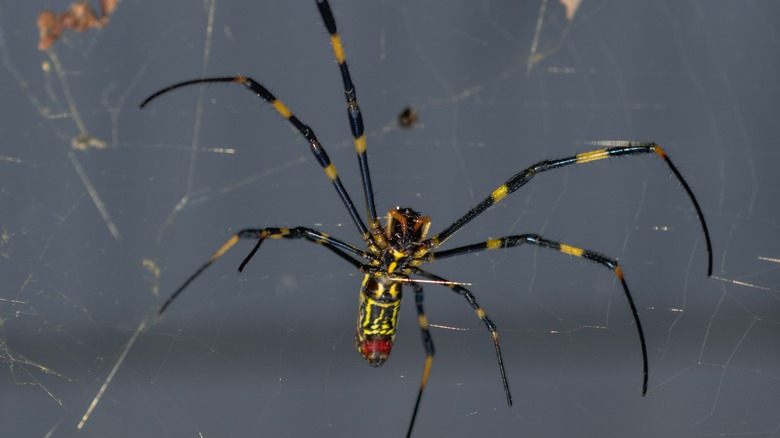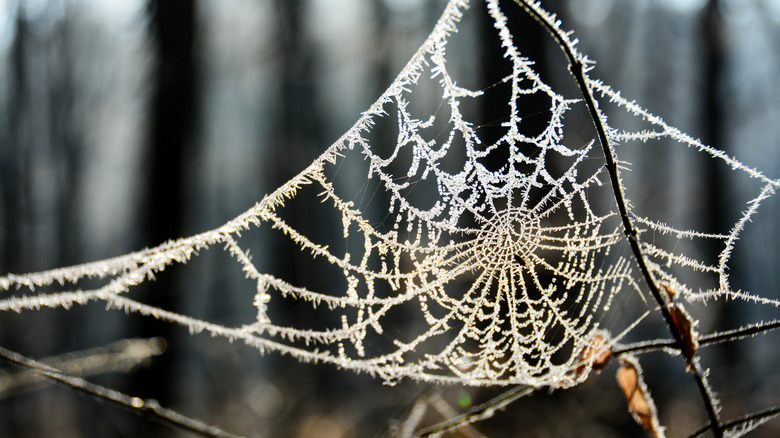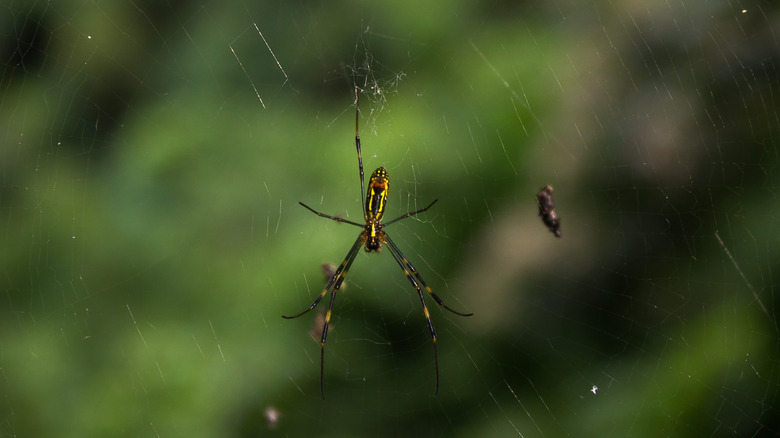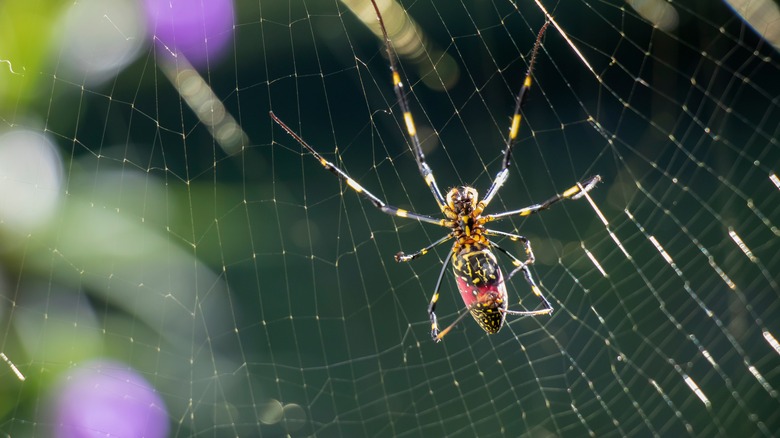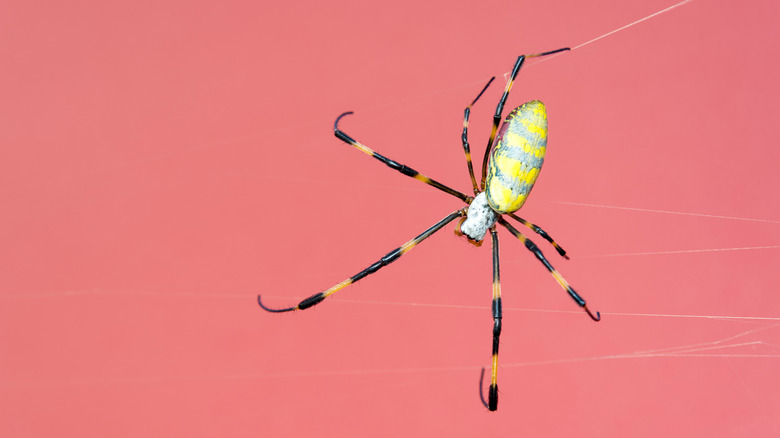Everything You Need To Know About The Giant Joro Spider Invasion
Joro spiders look pretty scary — and these large, colorful spiders can "fly." They're about the size of the palm of an adult's hand. Besides their terrifying looks, is there actually cause for concern? How did they get to the United States, and how can you spot one?
According to Smithsonian Magazine, joro spiders aren't native to the United States — they originally come from Japan. As NPR reports, joro spiders are named after Jorōgumo, a creature with origins in Japanese folklore. The story goes that Jorōgumo can shapeshift its form to become a woman and trick men into becoming its prey.
In fact, the joro spider isn't even new to the U.S. They reportedly first arrived here in 2013, nearly a decade ago (via Smithsonian Magazine). The spiders will sometimes crawl into shipping containers, which then get loaded onto transatlantic ships, taking the joro along for an intercontinental ride. CNN quotes Benjamin Frick, a University of Georgia researcher: "The reality of the situation, though, is that for every spider that we might see being transported, there are likely 10 more that evade detection."
This is only one way that the arachnid moves, though. They also have a second method of transport to get around on their own. It's ingenious.
Surviving cold temperatures
Smithsonian Magazine reports that the joro flies, sort of, by making a parachute out of spider web. This enables them to fly long distances of up to 100 miles when conditions are windy. According to CNN, this is called "ballooning." It's most common with freshly-hatched joro spiderlings, who use their silky webs and gusts of wind to travel.
The spiders are quite resilient. USA Today reports that the joro can usually survive in cold temperatures, even when it gets below freezing. However, according to CNN, many experts don't believe that the spiders will survive in cold temperatures in the long term. One expert, Anne Danielson-Francois, an associate professor of biological sciences at the University of Michigan, told ABC-7 that in her opinion, the spiders probably won't get any further north than North Carolina, and won't spread west.
But not everyone agrees. According to Axios Washington D.C., "It looks like the joro could probably survive throughout most of the Eastern Seaboard here," said Andy Davis, a researcher who has studied the spiders' impact. Davis estimates they could travel as far east as Delaware or Washington D.C..
New concerns about the joro
Brand new concerns for the spider's ability to travel and survive cold temperatures were elevated by a February 2022 study by two University of Georgia researchers, Andrew Davis and Benjamin Frick (via Smithsonian Magazine).
Their study, per the Royal Entomological Society, found that joro spiders can survive in lower temperatures than was previously known. Because of their fast heart rate, they can handle the cold better than other similar spiders in their genus, like the golden silk spider. The two researchers wrote that their findings "suggest the jorō spider can exist in a colder climatic region than the southeastern USA," raising new worries about how far exactly the arachnids might travel.
In order to spot a joro spider, look for a pattern that is a mix of black, yellow, blue, and red (via Axios Washington D.C.). They tend to grow big during the summer months, often between June and August. These arachnids can grow to be three to four inches across, with long, spindly legs (per CNN). The palm-sized joro spider spins a web that is golden in color (via NPR).
'Spiders are our friends'
There are good reasons to leave the joro spiders and their golden webs alone, reports NPR. These spiders can be a new food source for bigger animals, like birds. Joros themselves often snack on common household pests, like stink bugs (via Smithsonian Magazine). The spiders don't seem to have much effect on any American ecosystems.
The spiders' big webs can be a nuisance, but they won't hurt you. Andy Davis, a research scientist working at the Odum School of Ecology, told NPR, "If they're literally in your way, I can see taking a web down and moving them to the side, but they're just going to be back next year."
Smithsonian Magazine quotes Nancy Hinkle, an entomologist from the University of Georgia, who said, "This is wonderful. This is exciting. Spiders are our friends. They are out there catching all the pests we don't want around our home."
Dangerous, or just scary-looking?
And there is more good news — the joro isn't even particularly dangerous to human beings (via CNN). They are a venomous species, which means they poison insects before eating them. But joros won't attack people or pets unless they're trapped or cornered. And even then, their fangs can't actually penetrate through human skin.
Since there is virtually no danger to people, scientists are more concerned about the spiders' impact on creatures that are already living in the United States. Per Smithsonian Magazine, Dave Coyle, who teaches about forest health and invasive species as a professor at Clemson University, said, "You really don't know if this is displacing native stuff or not."
As Axios Washington D.C. reports, you may start seeing the spiders flying or crawling around by springtime. Millions of them could be spotted flying through the air. But there's no need to worry, since these creatures, although scary looking, are basically harmless in terms of a direct threat to humans.
What to do if you see a joro spider
What should you do if you spot a joro spider, either crawling in your home or swooping through the air? First, resist the urge to kill it.
"There's really no reason to go around actively squishing them. Humans are at the root of their invasion. Don't blame the joro spider," Frick advised in a statement about the spider (via Smithsonian Magazine). Instead, it's best to just leave them alone.
CNN spoke with Paula Cushing, who works as a senior curator of invertebrate zoology at the Denver Museum of Nature and Science. She wasn't upset about their impact either. Cushing said, "The biggest danger to humans is that you might get a face-full of lovely golden silk if you walk through the web."
The joro spiders are far more helpful than harmful. As Frick said to CNN, "People should not embark on spider genocide — all this would achieve is the needless killing of a beautiful animal."
